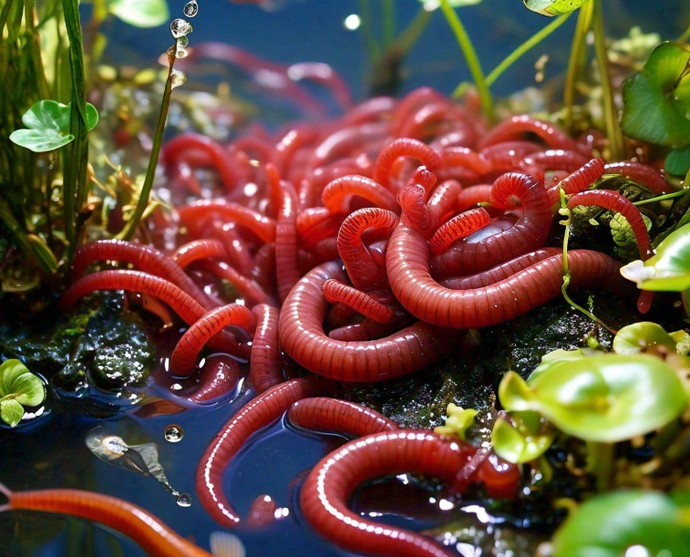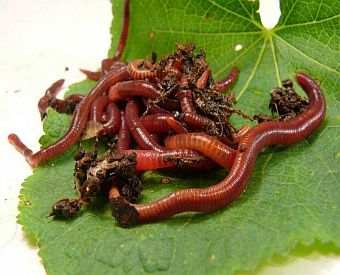Just How Red Wigglers Can Increase Your Organic Waste Recycling
Red wigglers represent a crucial element in improving organic waste recycling, successfully converting everyday cooking area scraps and garden particles right into valuable worm castings. Recognizing the intricacies of establishing a vermicomposting system and the optimum treatment for these worms can substantially magnify the benefits.

Advantages of Red Wigglers
Red wigglers, a sort of composting earthworm, deal various benefits that make them indispensable in natural waste recycling. Their capacity to eat a large selection of organic materials makes them highly effective decomposers. These worms can process kitchen area scraps, garden waste, and also paper products, transforming them right into nutrient-rich castings. This procedure not just minimizes the quantity of waste sent out to garbage dumps however additionally enhances soil health.
In addition, red wigglers improve dirt oygenation and drain with their tunneling activities, advertising a healthier origin setting for plants. Their castings are abundant in useful microbes and crucial nutrients, fostering durable plant growth and enhancing soil framework (red wigglers). The use of red wigglers in composting is an ecologically friendly alternative to chemical plant foods, which can have hazardous side impacts.
Furthermore, vermicomposting with red wigglers is a low-maintenance and reliable technique of reusing natural waste, making it accessible for households and communities alike. Their quick reproduction price makes certain a stable supply for ongoing composting efforts, better amplifying their advantages. Generally, red wigglers work as a crucial component in sustainable waste monitoring and dirt improvement techniques.
Establishing a Vermicomposting System
Developing a reliable vermicomposting system requires mindful preparation and consideration of numerous variables that contribute to its success. The structure of a successful system begins with selecting a proper container. Alternatives range from business containers to homemade choices, but it is important that the container is well-ventilated and appropriately sized to accommodate the variety of red wigglers.
Next, the selection of bed linens product is important. Ideal bed linens includes shredded newspaper, cardboard, or coconut coir, which gives both a habitat and a source of carbon for the worms. The bed linen needs to be dampened but not extremely wet to avoid anaerobic conditions.
Maintaining the ideal atmosphere is essential. Red wigglers flourish in temperatures in between 55 ° F and 77 ° F(13 ° C to 25 ° C )and require a pH level around neutral. Keeping an eye on moisture levels is additionally crucial, as also much wetness can cause smell issues, while also little can dry out the worms.
Last but not least, putting the vermicomposting system in a shaded area protected from direct sunshine will aid preserve a secure setting. With these considerations in mind, one can efficiently establish up a growing vermicomposting system that improves natural waste recycling.
What to Feed Red Wigglers
Feeding red wigglers the appropriate products is essential to preserving a healthy and balanced vermicomposting system. These worms flourish on a diverse diet plan largely made up of raw material, that includes fruit and vegetable scraps, coffee premises, crushed eggshells, and shredded paper. It is necessary to stay clear of feeding them meat, dairy, oily foods, or any processed look here things, as these can produce odors, draw in parasites, and lead to an undesirable setting.
A balanced diet for red wigglers promotes optimum digestion and nutrient production. Objective for a mix of eco-friendly materials, high in nitrogen, such as veggie peels and lawn cuttings, and brownish products, abundant in carbon, like dried fallen leaves and cardboard. This equilibrium makes certain a lasting food resource while preserving dampness degrees in the worm container.
Furthermore, it is recommended to chop or shred larger scraps to speed up disintegration and make the food more available to the worms. Frequently keeping an eye on the usage rate will assist determine the proper quantity to feed, preventing overfeeding and keeping a prospering ecosystem. By offering an ideal diet, you not just support the health and wellness of red wigglers but additionally improve the effectiveness of your vermicomposting initiatives.
Maintaining Your Worm Container
To ensure the health and wellness and performance of your vermicomposting system, maintaining your worm container is vital. If it comes to be also damp, excess moisture can lead to anaerobic problems, hurting your worms.
Temperature is another crucial element. Preferably, the worm container need to be kept between 55 ° F and 77 ° F(13 ° C to 25 ° C) Extreme temperatures can worry or eliminate your worms. To accomplish this, position your container in a climate-controlled atmosphere away from direct sunshine or warm resources.
Oygenation is crucial for oxygen flow. Gently transforming the bedding with a garden fork every few weeks will aid aerate the material and avoid compaction. In addition, be alert regarding the bin's smell. A nasty smell may suggest overfeeding or a discrepancy in the carbon-to-nitrogen proportion. If this occurs, minimize feeding and include more carbon-rich products like shredded paper or cardboard.
Making Use Of Worm Spreadings in Horticulture

(red wiggler earthworms for sale)
Worm spreadings, usually described as "black gold" by gardeners, are an extremely nourishing organic plant food that can significantly enhance soil health and wellness and plant development. These spreadings are created by red wigglers as they absorb raw material, leading to a rich, dark, brittle substance teeming with advantageous microorganisms.
Incorporating worm spreadings right into yard dirt enhances its structure, aeration, and moisture retention, developing an optimum environment for origin advancement. The high nutrient web content of worm castings, including nitrogen, phosphorus, and potassium, adds to strenuous plant growth and increased returns. Furthermore, worm spreadings have vital trace element and enzymes that promote the overall wellness of plants, allowing them to better endure pests and diseases.
Worm castings can be used directly to the soil or mixed into potting mixes for container gardening. A slim layer spread over garden beds or added to compost piles can likewise improve the microbial activity and nutrient account of the compost. As a sustainable and environment-friendly fertilizer option, worm castings sustain natural gardening techniques while minimizing reliance on synthetic plant foods, thus cultivating a healthier environment.
Final Thought
To conclude, the integration of red wigglers into natural waste reusing practices provides a viable option for boosting soil wellness and advertising lasting horticulture techniques. By effectively breaking down cooking area scraps and garden waste, red wigglers add to nutrient-rich worm castings that enhance dirt oygenation and moisture retention. This environmentally friendly strategy not only minimizes landfill payments but likewise decreases the dependancy on chemical plant foods, eventually fostering much healthier ecosystems and accountable waste administration practices.
Comments on “Red worms: Best practices for care”